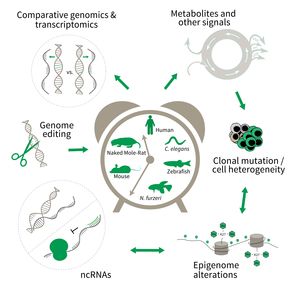Subarea 3: Genetics and Epigenetics of Aging
The focus of Subarea 3 is on genetic and epigenetic determinants of life- and health span as well as aging in fish, rodents and humans. This line of research builds on the expertise of the institute in comparative and functional genomics.
The research is defined by five focus areas:
- Comparative genomics in short- and long-lived models of aging,
- Genomic engineering in N. furzeri,
- Epigenetics of aging,
- Non-coding RNAs in aging, and
- Comparative transcriptomics of aging.
Research focus of Subarea 3.
To uncover causative factors for aging, comparative genomics in short- and long-lived model systems are applied. Functional genomics is used to identify novel pathways contribute to aging of an organism and to validate the functional relevance of genetic and epigenetic changes that occur during aging. Furthermore, genetic risk factors for aging-related diseases are identified and functionally tested. The future development of the Subarea aims to integrate changes in host-microbiota interactions during aging, and how these influence clonal mutation and epigenetic alterations through metabolites and other signals.
Publications
(since 2016)
2018
- Haplotypes composed of minor frequency single nucleotide polymorphism of tnf gene protect from progression into sepsis: A study using the new sepsis classification.
Retsas T, Huse K, Lazaridis LD, Karampela N, Bauer M, Platzer M, Kolonia V, Papageorgiou E, Giamarellos-Bourboulis EJ, Dimopoulos G
Int J Infect Dis 2018, 67, 102-6 - The African turquoise killifish Nothobranchius furzeri as amodel for aging research
Reuter* H, Singer* P, Krug* J, Englert C
Drug Discovery Today: Disease Models 2018, 27, 15-22 * equal contribution - Higher gene expression stability during aging in long-lived giant mole-rats than in short-lived rats.
Sahm A, Bens M, Henning Y, Vole C, Groth M, Schwab M, Hoffmann S, Platzer* M, Szafranski* K, Dammann* P
Aging (Albany NY) 2018, 10(12), 3938-56 * equal contribution - Long-lived rodents reveal signatures of positive selection in genes associated with lifespan.
Sahm A, Bens M, Szafranski K, Holtze S, Groth M, Görlach M, Calkhoven C, Müller C, Schwab M, Kraus J, Kestler HA, Cellerino A, Burda H, Hildebrandt T, Dammann P, Platzer M
PLoS Genet 2018, 14(3), e1007272 - Neuron-specific inactivation of Wt1 alters locomotion in mice and changes interneuron composition in the spinal cord
Schnerwitzki D, Perry S, Ivanova A, Viegas Caixeta F, Cramer P, Guenther S, Weber K, Tafreshiha A, Becker L, Vargas Panesso IL, Klopstock T, Hrabe de Angelis M, Schmidt M, Kullander K, Englert C
Life Science Alliance 2018, 1(4), e201800106 - Regulation of RNA Polymerase I Transcription in Development, Disease, and Aging.
Sharifi S, Bierhoff H
Annu Rev Biochem 2018, 87, 51-73 - The Definition of Open Reading Frame Revisited.
Sieber P, Platzer M, Schuster S
Trends Genet 2018, 34(3), 167-70 - Generation and characterization of telomerase (tert) mutants in Nothobranchius furzeri.
Singer P
Dissertation 2018, Jena, Germany - The microRNA miR-21 Is a Mediator of FGF8 Action on Cortical COUP-TFI Translation.
Terrigno M, Bertacchi M, Pandolfini L, Baumgart M, Calvello M, Cellerino A, Studer M, Cremisi F
Stem Cell Reports 2018, 11(3), 756-69 - Corrigendum: Regulation of microRNA expression in the neuronal stem cell niches during aging of the short-lived annual fish Nothobranchius furzeri.
Terzibasi Tozzini E, Savino A, Ripa R, Battistoni G, Baumgart M, Cellerino A
Front Cell Neurosci 2018, 12, 227 Erratum for Front Cell Neurosci 2014 volume 8 page 51









